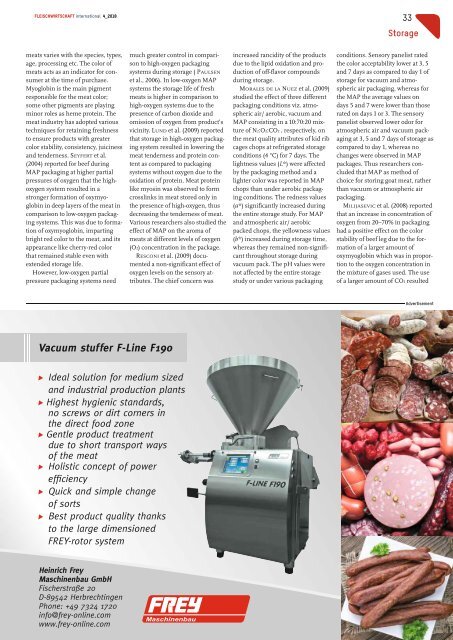FLEISCHWIRTSCHAFT international_04_2018
- No tags were found...
Create successful ePaper yourself
Turn your PDF publications into a flip-book with our unique Google optimized e-Paper software.
Fleischwirtschaft <strong>international</strong> 4_<strong>2018</strong><br />
33<br />
Storage<br />
meats varies with the species, types,<br />
age, processing etc. The color of<br />
meats acts as an indicator for consumer<br />
at the time of purchase.<br />
Myoglobin is the main pigment<br />
responsible for the meat color;<br />
some other pigments are playing<br />
minor roles as heme protein. The<br />
meat industry has adopted various<br />
techniques for retaining freshness<br />
to ensure products with greater<br />
color stability, consistency, juiciness<br />
and tenderness. SEYFERT et al.<br />
(20<strong>04</strong>) reported for beef during<br />
MAP packaging at higher partial<br />
pressures of oxygen that the highoxygen<br />
system resulted in a<br />
stronger formation of oxymyoglobin<br />
in deep layers of the meat in<br />
comparison to low-oxygen packaging<br />
systems. This was due to formation<br />
of oxymyoglobin, imparting<br />
bright red color to the meat, and its<br />
appearance like cherry-red color<br />
that remained stable even with<br />
extended storage life.<br />
However, low-oxygen partial<br />
pressure packaging systems need<br />
much greater control in comparison<br />
to high-oxygen packaging<br />
systems during storage ( PAULSEN<br />
et al., 2006). In low-oxygen MAP<br />
systems the storage life of fresh<br />
meats is higher in comparison to<br />
high-oxygen systems due to the<br />
presence of carbon dioxide and<br />
omission of oxygen from product’s<br />
vicinity. LUND et al. (2009) reported<br />
that storage in high-oxygen packaging<br />
system resulted in lowering the<br />
meat tenderness and protein content<br />
as compared to packaging<br />
systems without oxygen due to the<br />
oxidation of protein. Meat protein<br />
like myosin was observed to form<br />
crosslinks in meat stored only in<br />
the presence of high-oxygen, thus<br />
decreasing the tenderness of meat.<br />
Various researchers also studied the<br />
effect of MAP on the aroma of<br />
meats at different levels of oxygen<br />
(O2) concentration in the package.<br />
RESCONI et al. (2009) documented<br />
a non-significant effect of<br />
oxygen levels on the sensory attributes.<br />
The chief concern was<br />
increased rancidity of the products<br />
due to the lipid oxidation and production<br />
of off-flavor compounds<br />
during storage.<br />
MORALES DE LA NUEZ et al. (2009)<br />
studied the effect of three different<br />
packaging conditions viz. atmospheric<br />
air/ aerobic, vacuum and<br />
MAP consisting in a 10:70:20 mixture<br />
of N2:O2:CO2 , respectively, on<br />
the meat quality attributes of kid rib<br />
cages chops at refrigerated storage<br />
conditions (4 °C) for 7days. The<br />
lightness values (L*) were affected<br />
by the packaging method and a<br />
lighter color was reported in MAP<br />
chops than under aerobic packaging<br />
conditions. The redness values<br />
(a*) significantly increased during<br />
the entire storage study. For MAP<br />
and atmospheric air/ aerobic<br />
packed chops, the yellowness values<br />
(b*) increased during storage time,<br />
whereas they remained non-significant<br />
throughout storage during<br />
vacuum pack. The pH values were<br />
not affected by the entire storage<br />
study or under various packaging<br />
conditions. Sensory panelist rated<br />
the color acceptability lower at 3, 5<br />
and 7days as compared to day 1 of<br />
storage for vacuum and atmospheric<br />
air packaging, whereas for<br />
the MAP the average values on<br />
days 5 and 7 were lower than those<br />
rated on days 1 or 3. The sensory<br />
panelist observed lower odor for<br />
atmospheric air and vacuum packaging<br />
at 3, 5 and 7days of storage as<br />
compared to day 1, whereas no<br />
changes were observed in MAP<br />
packages. Thus researchers concluded<br />
that MAP as method of<br />
choice for storing goat meat, rather<br />
than vacuum or atmospheric air<br />
packaging.<br />
MILIJASEVIC et al. (2008) reported<br />
that an increase in concentration of<br />
oxygen from 20–70% in packaging<br />
had a positive effect on the color<br />
stability of beef leg due to the formation<br />
of a larger amount of<br />
oxymyoglobin which was in proportion<br />
to the oxygen concentration in<br />
the mixture of gases used. The use<br />
of a larger amount of CO2 resulted<br />
Advertisement

















